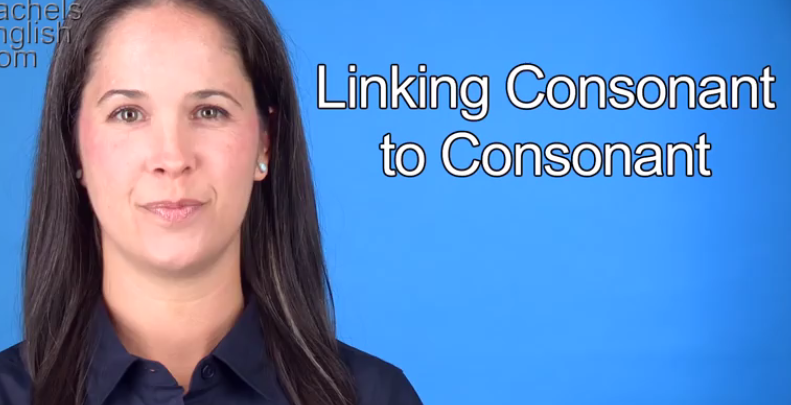In this American English pronunciation video, we're going to go over linking consonant to consonant.
在这个美式英语发音视频里,我们来看一看辅音和辅音之间的连读。
Linking is an important part of American English.If we break between each word, it sounds very choppy.
连读是美式英语里面很重要的一部分。如果我们在每个单词之间都停顿的话,听起来就会很不连贯。
But in American English, we like to link words together for a smooth sound.
但是在美式英语中,我们会将单词连读起来,以此来达到通顺的效果。
I've already made videos on linking Vowel to Vowel and Consonant to Vowel.
我之前已经做过关于元音与元音之间、辅音与元音之间连读的视频了。
Linking Consonant to Consonant happens all the time in American English.
辅音和辅音之间的连读在美式英语里很常见。

In that sentence right there it happened four times: ng-kk, nt-tt, nt-hh, and ll-th.
在上面那个句子里,它就出现了四次:ng-kk, nt-tt, nt-hh 和 ll-th。
We can't cover every example of linking consonant to consonant as there are simply too many combinations for this video, but I will give you some examples.
我们不可能涉及到每一个辅音和辅音连读的例子,因为有太多的组合,这一个视频里不可能涉及到所有的组合,但是我会给你们举一些例子。
First let's talk about linking the same consonant.Take the example "gas station".
首先,我们来讨论相同辅音的连读。比如说“gas station”。
It's not "gas station", with two separate S's, it's "gas station": one S, connecting the two words.
不能读成“gas station”,两个分开的S,而要读成“gas station”,用一个S连接两个单词。
"I'm going to the gas station."I already used this example last year when I took a road trip.
"I'm going to the gas station."我在去年旅行的时候已经用过这个例子了。
Click here to see that video, or go to the video description.Another example: "some might, some might."
点击这里看那个视频,或者去看视频介绍。另一个例子:"some might, some might."
Again, not "some might", but "some might", connected with one M."Some might think so."
同样的,不是“some might”,而是“some might”,用一个M连接。"Some might think so."
The rule gets a little complicated when we bring in Stop Consonants.The six stop consonants are t, d, p, b, k, and g.
当加入顿音辅音时,连读规则就变得复杂一些了。六个顿音辅音是 t, d, p, b, k 和 g。
When these meet in between two words, like "hot today", you have to stop the air to signify the first consonant, then release the sound into the next word.
当这些辅音出现在单词之间时,比如“hot today”,你要停顿一下来表示第一个辅音,然后再发下个单词的音。
So, it's not "hahtoday, hahtoday", but "hot today", with a stop, "hot today, hot today".
因此,不是“hahtoday, hahtoday”,而是“hot today”,中间停顿一下,"hot today, hot today"。
So to make that stop, I'm just holding the air in my throat, for a fraction of a second, "hot today, hot today."
因此停顿的时候,我将气息保留在喉咙处,停留不到一秒的时间,"hot today, hot today."
Another example, "bad dog".It's not "baadog", but "bad dog, bad dog, bad dog", with a stop.
另一个例子,“bad dog”。不是“baadog”,而是"bad dog, bad dog, bad dog",停顿一下。
This is true in general when we're linking a stop consonant to any other consonant.
在把顿音辅音和其他的任何辅音连读时,这个规则一般都是适用的。
For example, "peanut butter, peanut butter" – stopped T, released B, "peanut butter".
比如,"peanut butter, peanut butter"——顿音T,发出B音,"peanut butter"。
Not "peanuh butter, peanuh butter", with no stop, but also not "peanut butter" with a released T, but "peanut butter, peanut butter.""Flip phone."
不是"peanuh butter, peanuh butter",没有停顿,也不是"peanut butter",发出T音,而是"peanut butter, peanut butter.""Flip phone."
Here we stop the sound with the lips in position for the P, then go straight into the F consonant without releasing the P.
在这里,当唇部做出P音的形状时停顿,然后直接发辅音F,不发P音。
"Flip phone, flip phone."It's not "flip phone", with a full release, and it's not "flihphone", with no stop of air.
"Flip phone, flip phone."不是"flip phone",将P音完全发出,也不是"flihphone",没有停顿。
We have to stop the air."Flip phone, flip phone."
我们必须停顿。"Flip phone, flip phone."
This way of linking ending stop consonants to words that begin with another consonant is a great trick to add to your English if you haven't already.
这种将单词结尾的辅音与其他以辅音开头的单词连读的方法是一个很好的技巧,如果你还没有用过这种技巧的话,可以把它加入你的英语当中。
Some students have trouble with this, and add an additional schwa sound between words in order to link in these situations.
一些学生在做这个时有点问题,会把单词中间加入一个弱读音,以此来在这些情况下连读。
So "hot sauce" becomes something more like "hot-uh-sauce, hot-uh-sauce".
所以,"hot sauce"变成了"hot-uh-sauce, hot-uh-sauce"。
So remember, don't release that ending stop consonant, just stop the air.
因此要记得,不要把结尾的顿音辅音发出来,停顿一下就好了。
For all other cases, you'll just need to isolate the two sounds in question and practice.
对于所有的其他情况,你只需要把两个音分开练习就好了。
Let's take for example "It's a tough one".Here we're linking the F and W sounds.Practice them separately, ff, ww, ff, ww.
比如说"It's a tough one"。在这里,我们要把F音和W音连读。把它们分开练习,ff, ww, ff, ww。
Now practice them together, sliding slowly from one sound to the other, ff-ww, ff-ww.
现在把它们放在一起练习,慢慢地从一个音滑向另一个音,ff-ww,ff-ww。
Really think about what you're moving to transition in-between these two sounds.
想一下在这两个音之间你要怎样过渡。
In this case, my bottom lip was touching the bottom of the top front teeth, ff, and then the lips round out.
在这个例子中,我的下唇抵着下排牙齿的上端,发出ff音,然后双唇放松。
My tongue doesn't have to move."Ff-ww, ff-ww, tough one, tough one.""Tough one. It's a tough one."
我的舌头不需要移动。"Ff-ww, ff-ww, tough one, tough one.""Tough one. It's a tough one."
So, isolate the sounds, practice them separately, practice them together slowly, speed them up and put them back into the context of the words and eventually the sentence.
所以,把音分离出来,然后分开练习,放在一起慢慢练习,加快速度,然后把它们放回单词里,最后放回句子里练习。
Let's look at one more example.We'll link the N sound to the R sound: On Rachel's desk.
让我们再看一个例子。我们要把N音和R音连读:On Rachel's desk.
Here, my lips and tongue have to move."Nn, rr, nn, rr."Now link them together slowly: "nn, rr, nn, rr."
在这里,我的唇部和舌头都要动。"Nn, rr, nn, rr."现在慢慢地把它们连在一起:"nn, rr, nn, rr."
You may see my lips are rounding a little bit as I'm making the N, that's in preparation for the R, "nn, rr."
你可能看到我在发N音时唇部稍微有一点圆,这是在为R音做准备,"nn, rr."
The tongue goes from having the top part of the front of the tongue at the roof of the mouth here, "nn, rr",
舌头位置的变化是,从舌头前面部分接触上颚,“nn, rr”,
to having the front part of the tongue touching nothing as the tongue pulls back for the R.
到舌头收回,为发R音做准备时,舌头前面部分不接触任何位置。
So for the R, the middle part of the tongue is touching the roof of the mouth, or maybe the insides of the teeth, about here.
因此,发R音时,舌头中间的部分是抵着上颚的,或者是牙齿的里面,大概在这里。
"Nn-rr. Onn-Rr, Onn-Rrachel's."I'm really feeling the tongue move up and then back, "on Rachel's, on Rachel's."
"Nn-rr. Onn-Rr, Onn-Rrachel's."我真的感觉到了舌头向上移动,然后再回来,"on Rachel's, on Rachel's."
"On Rachel's desk."Check out the other videos that I've made, that address some consonant to consonant linking.
"On Rachel's desk."看一下我做的其他视频,那些视频讲了一些辅音和辅音之间的连读。
Take any short text and look for words that should link consonant to consonant.
选择任何的短文章,然后找一些带有辅音和辅音连读的单词。
For each case, think about what kind of linking it is.Is the consonant the same?Is the first consonant a stop consonant?
对于每个例子,想一下它是哪种类型的连读。辅音是一样的吗?第一个辅音是顿音辅音吗?
Practice it slowly.Linking is a crucial part of smoothing out speech, sounding American.
慢慢练习。连读是在做到演讲通顺、听起来更美式当中一个很重要的部分。
Put an example of a simple sentence where you would need to link consonant to consonant below in the comments.
在下面的评论里写出一个简单的你认为需要连读辅音的句子。
Practice with the sentences that everyone else puts!That's it, and thanks so much for using Rachel's English.
练习一下其他人评论的句子!这次的学习就到这里,非常感谢使用Rachel's English。


